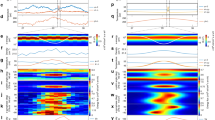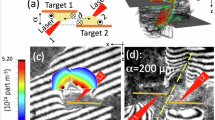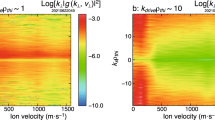Abstract
Self-organization1,2 occurs in plasmas when energy progressively transfers from smaller to larger scales in an inverse cascade3. Global structures that emerge from turbulent plasmas can be found in the laboratory4 and in astrophysical settings; for example, the cosmic magnetic field5,6, collisionless shocks in supernova remnants7 and the internal structures of newly formed stars known as Herbig–Haro objects8. Here we show that large, stable electromagnetic field structures can also arise within counter-streaming supersonic plasmas in the laboratory. These surprising structures, formed by a yet unexplained mechanism, are predominantly oriented transverse to the primary flow direction, extend for much larger distances than the intrinsic plasma spatial scales and persist for much longer than the plasma kinetic timescales. Our results challenge existing models of counter-streaming plasmas and can be used to better understand large-scale and long-time plasma self-organization.
This is a preview of subscription content, access via your institution
Access options
Subscribe to this journal
Receive 12 print issues and online access
$259.00 per year
only $21.58 per issue
Buy this article
- Purchase on SpringerLink
- Instant access to full article PDF
Prices may be subject to local taxes which are calculated during checkout



Similar content being viewed by others
References
Ball, P. The Self-Made Tapestry: Pattern Formation in Nature (Oxford Univ. Press, 1999).
Cross, M. C. & Hohenberg, P. C. Pattern formation outside of equilibrium. Rev. Mod. Phys. 65, 851–1112 (1993).
Diamond, P. H., Itoh, S-I. & Itoh, K. in Modern Plasma Physics (Physical Kinetics of Turbulent Plasmas, Vol. 1, Cambridge Univ. Press, 2010).
Yamada, T. et al. Anatomy of plasma turbulence. Nature Phys. 4, 721–725 (2008).
Zweibel, E. G. & Heiles, C. Magnetic fields in galaxies and beyond. Nature 385, 131–136 (1997).
Ryu, D., Kang, H., Cho, J. & Das, S. Turbulence and magnetic fields in the large-scale structure of the Universe. Science 320, 909–912 (2008).
Spicer, D. S., Maran, S. P. & Clark, R. W. A model of the pre-Sedov expansion phase of supernova remnant-ambient plasma coupling and X-ray emission from SN 1987A. Astrophys. J. 356, 549–571 (1990).
Reipurth, B. & Bally, J. Herbig–Haro flows: Probes of early stellar evolution. Annu. Rev. Astronom. Astrophys. 39, 403–455 (2001).
Ross, J. S. et al. Characterizing counter-streaming interpenetrating plasmas relevant to astrophysical collisionless shocks. Phys. Plasmas 19, 056501 (2012).
Park, H-S. et al. Studying astrophysical collisionless shocks with counterstreaming plasmas from high power lasers. High Energy Density Phys. 8, 38–45 (2012).
Hatchett, S. P. et al. Electron, photon, and ion beams from the relativistic interaction of petawatt laser pulses with solid targets. Phys. Plasmas 7, 2076–2082 (2000).
Snavely, R. A. et al. Intense high-energy proton beams from petawatt-laser irradiation of solids. Phys. Rev. Lett. 85, 2945–2948 (2000).
Nye, J. F. Natural Focusing and Fine Structure of Light: Caustics and Wave Dislocations (Institute of Physics Publishing, 1999).
Kugland, N. L., Ryutov, D. D., Plechaty, C., Ross, J. S. & Park, H-S. Relation between electric and magnetic field structures and their proton-beam images. Rev. Sci. Instrum. 83, 101301 (2012).
Remington, B. A., Arnett, D., Drake, R. P. & Takabe, H. Modeling astrophysical phenomena in the laboratory with intense lasers. Science 284, 1488–1493 (1999).
Ryutov, D. et al. Similarity criteria for the laboratory simulation of supernova hydrodynamics. Astrophys. J. 518, 821–832 (1999).
Remington, B. A., Drake, R. P. & Ryutov, D. D. Experimental astrophysics with high power lasers and Z pinches. Rev. Mod. Phys. 78, 755–807 (2006).
Gregori, G. et al. Generation of scaled protogalactic seed magnetic fields in laser-produced shock waves. Nature 481, 480–483 (2012).
Ray, T. P. et al. Large-scale magnetic fields in the outflow from the young stellar object T Tauri S. Nature 385, 415–417 (1997).
Hartigan, P., Frank, A., Varniere, P. & Blackman, E. G. Magnetic fields in stellar jets. Astrophys. J. 661, 910–918 (2007).
Gardiner, T. A., Frank, A., Jones, T. W. & Ryu, D. Influence of magnetic fields on pulsed, radiative jets. Astrophys. J. 530, 834–850 (2000).
Takabe, H. et al. High-Mach number collisionless shock and photo-ionized non-LTE plasma for laboratory astrophysics with intense lasers. Plasma Phys. Control. Fusion 50, 124057 (2008).
Drake, R. P. & Gregori, G. Design considerations for unmagnetized collisionless-shock measurements in homologous flows. Astrophys. J. 749, 171–185 (2012).
Kulsrud, R. M., Cen, R., Ostriker, J. P. & Ryu, D. The protogalactic origin for cosmic magnetic fields. Astrophys. J. 480, 481–491 (1997).
Bernet, M. L., Miniati, F., Lilly, S. J., Kronberg, P. P. & Dessauges-Zavadsky, M. Strong magnetic fields in normal galaxies at high redshift. Nature 454, 302–304 (2008).
Kato, T. N. & Takabe, H. Nonrelativistic collisionless shocks in unmagnetized electron-ion plasmas. Astrophys. J. 681, L93–L96 (2008).
Kato, T. N. & Takabe, H. Electrostatic and electromagnetic instabilities associated with electrostatic shocks: Two-dimensional particle-in-cell simulation. Phys. Plasmas 17, 032114 (2010).
Ryutov, D. D. et al. Intra-jet shocks in two counter-streaming, weakly collisional plasma jets. Phys. Plasmas 19, 074501 (2012).
Stamper, J. A. et al. Spontaneous magnetic fields in laser-produced plasmas. Phys. Rev. Lett. 26, 1012–1015 (1971).
Zylstra, A. B. et al. Using high-intensity laser-generated energetic protons to radiograph directly driven implosions. Rev. Sci. Instrum. 83, 013511 (2012).
Acknowledgements
We thank the staff of the OMEGA EP laser facility for their experimental support. This work was performed under the auspices of the US Department of Energy by the Lawrence Livermore National Laboratory, under Contract No. DE-AC52-07NA27344. Further support was provided by LLNL LDRD grant No. 11-ERD-054 and the International Collaboration for High Energy Density Science (ICHEDS), supported by the Core-to-Core Program of the Japan Society for the Promotion of Science. The research leading to these results received funding from the European Research Council under the European Community’s Seventh Framework Programme (FP7/2007-2013), ERC grant agreement nos 256973 and 247039.
Author information
Authors and Affiliations
Contributions
N.L.K. and H-S.P. designed and prepared the experiment. The OMEGA EP experiments were carried out by N.L.K., H-S.P., G.G., M.K., Y.K., J.M., T.M., A.P., C.P., J.S.R. and Y.S. The paper was written by N.L.K., D.D.R. and G.G. The data were analysed by N.L.K. and D.D.R. Further experimental and theoretical support was provided by P-Y.C., R.P.D., G.F., D.H.F., S.H.G., M.G., C.K., M.C.L., E.L., F.M., R.P., A.R., B.A.R., B.R., A.S. and H.T.
Corresponding author
Ethics declarations
Competing interests
The authors declare no competing financial interests.
Supplementary information
Supplementary Information
Supplementary Information (PDF 365 kb)
Rights and permissions
About this article
Cite this article
Kugland, N., Ryutov, D., Chang, PY. et al. Self-organized electromagnetic field structures in laser-produced counter-streaming plasmas. Nature Phys 8, 809–812 (2012). https://doi.org/10.1038/nphys2434
Received:
Accepted:
Published:
Issue date:
DOI: https://doi.org/10.1038/nphys2434
This article is cited by
-
Self-organization of photoionized plasmas via kinetic instabilities
Reviews of Modern Plasma Physics (2023)
-
Digital nanosecond imaging architecture and analytical tracking technique of colliding laser-produced plasma
Optical and Quantum Electronics (2022)
-
Electron acceleration in laboratory-produced turbulent collisionless shocks
Nature Physics (2020)
-
Multi-scale simulations of particle acceleration in astrophysical systems
Living Reviews in Computational Astrophysics (2020)
-
Laboratory investigation of particle acceleration and magnetic field compression in collisionless colliding fast plasma flows
Communications Physics (2019)



